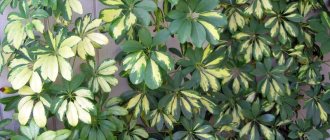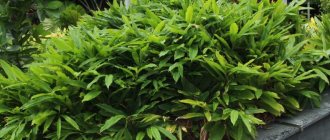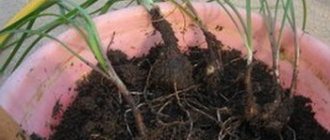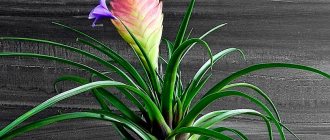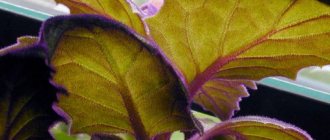Tillandsia anita is a decorative hybrid of blue Tillandsia; in natural conditions it grows not in soil, but on trees, receiving all the necessary substances from the air, rainwater and wood itself. Flat, wide inflorescences are attached to short peduncles and consist of pink or purple bracts, on which bright blue flowers open in turn. Flowering lasts a short time, but the bracts retain their decorative effect for a long time, until they become light green.
Description and photo
Tillandsia Anita - this decorative compact species has a dense rosette of gray-green leaves. The narrow and long foliage is only partially covered with scales. During the flowering period, a short, obovate, pink inflorescence is formed. Lilac or purple flowers bloom on it one by one, starting from the bottom. Under natural conditions, the plant receives moisture and nutrients from:
- dew;
- rain;
- fog;
- organic matter residues;
- dust settling on the leaves.
It is especially popular due to its increased decorative effect. In the center of a rosette formed from narrow leaves, surrounded by pinkish bracts, there is a blue flower. Although it fades quickly, the bracts retain their bright color for a long time, and then begin to turn green.
- Tillandsia Blue belongs to the herbaceous species and is cultivated as a potted crop.
- It has narrow, sharp leaves, reaching a length of 25-30 cm and collected in a dense rosette.
- The leaf blade is green, but at the very base it is reddish-brown and has longitudinal brown stripes over its entire surface.
- The peduncle appears once in the life of this plant. It grows from the middle of the rosette in summer and resembles a large flat spike, in which the bracts of pink-lilac colors are arranged alternately and overlap each other. The height of the peduncle ranges from 8 to 16 cm, the width is about 7 cm.
- Flowers of blue or light blue shades with 3 petals bent downwards bloom for only a short time, usually no more than a day. But there are many of them and they open one by one, creating the appearance of a blooming wave.
- Flowering is long lasting, lasting about 2 months.
Tillandsia Anita is a hybrid of the Blue Tillandsia and is very similar to it. It is distinguished by scaly leaves that have a pronounced gray tint. It was awarded to Anita by Tillandsia atmospherica, which was used in the process of breeding the variety.
When and how does it bloom
In order for the plant to bloom luxuriantly and profusely, it must be properly cared for. Thanks to this, the crop will retain its decorative properties. A characteristic feature of the plant is its flat inflorescence. It has a spike-shaped shape and is located on a small peduncle.
The bud includes flowers of a rich blue hue. Its structure also includes bright pink bracts. They overlap each other. The flowers fade quickly enough, and the spike with bracts lasts quite a long time. After flowering ends, shoots form in the leaf axils. The mother socket dies.
Description of the plant
Tillandsia in the wild
This plant received its name in honor of the Swedish botanist E. Tillands (1640 - 1693). In the wild, tillandsia is found most often in the tropical and subtropical regions of the American continent - in the southern USA, Mexico, Argentina and Chile, and it grows in the most unexpected places - in semi-deserts, swamps, savannas, mountainous areas, in the tropics and subtropics. It can be found even on the border of permafrost. There are many types of tillandsia: double-edged, which grows in Costa Rica; bulbous, found everywhere from Mexico to Brazil; Lindens - in Ecuador; horned - in the tropics of southern America. The shades of the original tillandsias are also varied: from blue-blue to yellow-green. Different varieties of tillandsia vary greatly in external characteristics and in their growing conditions.
Spectacular and catchy, these flowers amaze with their originality and diversity. Currently, the genus Tillandsia has united more than 400 species of flowering herbaceous plants: both perennials and annuals, both terrestrial species familiar to us, and epiphytes that are completely different from them.
In this article we will look at those types of tillandsias that belong to potted, or as they are also called, green tillandsias. They are more reminiscent of the familiar herbaceous plants from the Bromeliaceae family than epiphytes and are more often grown at home as indoor flowers.
Home care
Which pot should you choose? To transplant tillandsia, prepare a wide but shallow pot, as the flower develops in a specific way. Growth and daughter rosettes replace the mother ones, and growth occurs mainly in width. The root system of tillandsias is not too powerful and superficial. In a deep pot it will suffer from waterlogging. When replanting, remove the plant carefully, trying not to injure even the slightest roots. The rhizome does not hold the lush rosette of tillandsia well in loose soil. But try to compact the soil well and give the plant as much stability as possible.
When the plant has grown in width to the very walls of the pot, and the roots begin to peek out from the drainage holes, it is time to transplant the tillandsia into a new pot. Usually, two to three years pass from planting.
How to replant after purchasing in a store
Monocarpic species are replanted only once, after purchase in the store. Polycarpic plants are replanted in the spring, every two to three years. A thick layer of drainage is placed at the bottom of the pot, to which it is advisable to add charcoal.
The plant is carefully removed from the old pot, freeing its roots from the soil, and placed in a new pot. It should be wide and shallow, since the root system of a tropical plant is poorly developed. It is best to take a clay or ceramic container. If you use a plastic pot, then you need to make a lot of holes in it.
Every year in spring, the top layer of the substrate is changed.
If you bought a tillandsia in a store already with a peduncle, we recommend not to replant it. Place the pot with the tropical plant in a bright, warm place, and do not touch the flower until it fades.
Lighting - choosing a location
A tropical plant needs diffused light throughout the year. But it does not tolerate direct sunlight and extreme heat. Therefore, in summer the flower should be shaded. In winter, all varieties need lighting.
Plants with green leaves need bright light, while those with silver leaves grow well in partial shade.
With insufficient lighting, tillandsia leaves lose their decorative properties, and the inflorescences become pale and unattractive. If you really cannot do without lighting, it is better to use daylight diffused light lamps - tillandsia mistake them for natural light.
Watering
In summer, a tropical flower requires high humidity (60–70%). For potted Tillandsias, you need to constantly keep the soil moist, preventing it from drying out. It is also recommended to pour water inside the leaf rosettes. In winter, watering is reduced, allowing the soil to dry out a little. The plant should be sprayed regularly and generously. At the same time, moisture should be avoided on the stipules, which greatly reduces the duration of flowering.
SPECIAL ATTENTION is required for hanging species, aerial Tillandsias, which, due to the lack of roots, absorb moisture from the air. Therefore, they are recommended to have “baths” once a week, completely immersing them in water for 4-6 hours (after water procedures, Tillandsia should be placed on a soft towel and allowed to dry a little, then put it in its habitat in the apartment). Spraying is carried out three times a week.
To provide epiphytes with optimal humidity, it is advisable to place them in a florarium or place a humidifier nearby.
For watering and spraying use soft water. Distillate and tap water are not suitable for exotic plants. Sometimes, instead of watering, the entire pot with the plant is immersed in water overnight. In the morning, let the water drain freely - this way the earthen lump is saturated with moisture in abundance. It is necessary to water with warm, settled water. Sometimes, to soften the water, you can add a few drops of citric or acetic acid to it.
Temperature
In summer, the air temperature should fluctuate between 20–28⁰С. You can take the flower outside by placing it in a little shade. In winter, the temperature should be maintained at 18–24 degrees.
The tropical sissy cannot stand the cold. The minimum temperature for it is 13⁰С.
In summer, you can take pots with these flowers to the balcony, since it is known that tillandsias are great lovers of fresh air and frequent ventilation of the room in which they live. They are not afraid of light warm drafts, but they must be protected from cold, especially icy drafts, just like any indoor plants. It is advisable not to sharply change the temperature of the flower during ventilation.
The soil
Tillandsia will not grow in ordinary garden soil. The correct soil for planting tillandsia can be purchased at the store. Suitable soil mixture for flowering orchids. But if you decide to prepare the soil yourself, then take leaf soil, peat and chopped sphagnum moss in equal quantities, and add a little crushed charcoal. It is also good to add a mixture of fine spruce or fir bark, humus and sand. The main thing is that the substrate is loose.
Potted tillandsia requires airy and light soil. It should allow moisture to pass through well and allow the roots to breathe freely.
It is best to purchase a substrate for orchids. You can prepare the soil yourself by mixing leaf soil, sand, sphagnum and peat, as well as a small amount of charcoal in equal proportions.
Epiphytes do not need soil, since they do not have a root system. They are attached to the support by wrapping the bundle with sphagnum. An excellent option is driftwood with remnants of bark.
Fertilizers and fertilizing
In spring and summer, twice a month it is necessary to spray the leaves of the plant with fertilizer for bromeliads or orchids. It should not contain boron and copper. The concentration of the solution is reduced by 4 times compared to what is indicated in the instructions.
Do not fertilize the soil, which can have a detrimental effect on weak roots.
This operation is performed every 10–14 days. For this, a special complex of fertilizers for orchids is used. You just need to dilute it twice as weak. The same solution can be sprayed on the plant. A mixture of phosphorus with potassium and nitrogen in a ratio of 2: 1: 1 will be useful. Ten grams of this mixture are dissolved in a bucket of water and used as a complex fertilizer.
Kinds
Let's look at the most popular types of tillandsia with photos.
Blue (Tillandsia cyanea)
Blue Tillandsia (Tillandsia cyanea)
Blue Tillandsia (Cyanea) is the most popular flower for home care. It forms a bizarre rosette of grass-like leaves, the color of which varies from a reddish base to brown-striped plates. The height of the rosette reaches 30 cm. In summer, a flat spike with dense bracts, arranged in a bizarre pattern, grows from the center of the rosette. The fantastic coloring and shape of the bracts seem artificial. Blue or light blue flowers with rhombic petals bent to the sides bloom gradually, as if a wave rolls along the ear from its top to the base. The bracts are painted in bright lilac or pink tones.
This may be interesting: Ruellia - home care
Tillandsia lindenii
Tillandsia Lindena is similar to blue Tillandsia, but more graceful and beautiful. Its spike is more rounded, not so dense, and the bracts are only soft pink or reddish in color. The flowers of this tillandsia are also bright blue, three-petaled. The leaves are thinner and collected in relatively loose rosettes.
Tillandsia dyeriana
Tillandsia duera
The inflorescence of Tillandsia Duera resembles the yellow autumn leaf of an acacia tree. Elegant, very beautiful plant. It develops in the form of a rosette of tongue-shaped, flat and long leaves, tightly arranged, as if wrapped, around the base of the peduncle. In the center of the rosette, on a thin short peduncle, a symmetrical inflorescence grows with loose, double-rowed leaf-shaped oval bracts of orange or red shades.
Tillandsia Anita
Tillandsia Anita is an ornamental hybrid of blue Tillandsia. It is also popular for home care. Its dense rosette consists of narrow scaly leaves with pointed ends. Flat, wide inflorescences are attached to short peduncles and consist of pink or purple bracts, on which bright blue flowers open in turn. Flowering lasts a short time, but the bracts retain their decorative effect for a long time, until they become light green.
Tillandsia tricolor
Tillandsia tricolor
Another species is Tillandsia tricolor. Its linear, long (up to twenty cm), narrow (no more than 1 cm) scaly green leaves form a dense rosette. Peduncles are thin, long and erect. Inflorescences in the form of a spike can be both simple and complex (several ears). The ears consist of leathery, oval-shaped stipules, which have sepals, like a traffic light, in three colors: at the bottom they are bright red, in the middle they are light yellow, and at the very top they are green. In summer, large flowers bloom, the petals of which grow up to 7 cm in length and are colored purple.
Tillandsia Flabellata
Tillandsia Flabellata
The rosette of this Tillandsia species is formed by narrow, long, green leaves. Spectacular tubular bracts of bright orange-red color give the plant a decorative appearance.
Care during the flowering period
Tillandsia must be regularly ventilated, but avoid drafts. You should take care of good lighting, high-quality watering, and timely fertilizing.
If the plant does not produce flower stalks for a long time, then to stimulate flowering, the leaves are sprayed weekly with a Zircon solution.
What to do after flowering
We advise you not to cut the peduncle, because after a while children will appear on it, which will be useful for propagating the flower. No other types of pruning are needed for tillandsia.
Possible problems in growing
Tillandsia flower requires the creation of favorable microclimatic conditions. Pests can appear on a plant that is weakened by replanting or improper conditions.
Pests
The main danger to tillandsia is scale insects and scale insects. They are removed from the plant by wiping the leaves with a soap solution. In case of severe infection, special insecticides are used.
Other problems
Plants of the Bromeilaceae family are susceptible to fungal and viral diseases. Black spots appear on the leaves. To cure the plant, you need to trim off the affected leaves.
Main problems:
- The appearance of brown spots on the leaves is due to improper watering. It is necessary to adjust the hydration and use exclusively filtered water.
- Lack of formation of buds and flowers occurs with insufficient lighting and insufficient air humidity. The plant is moved to a bright room, an additional light source and an air humidifier are installed.
- Leaves may take on a brownish tint due to sunburn. In hot weather, the pot with the plant must be shaded, protecting it from direct sunlight.
- Flower rotting occurs if tillandsia is planted in ordinary soil. Or due to excess moisture in the soil. It is treated by completely replacing the soil.
- The leaves are curled and dry - there is not enough moisture, the plant should be sprayed more often.
Reproduction
The exotic plant can be propagated vegetatively (by children) or by seeds. Most often, gardeners prefer the first method, since seed propagation will require a lot of time and effort.
Reproduction by children
Side shoots are called children. Their rapid growth is observed during the flowering period. One plant can produce 3–8 daughter shoots.
- After flowering ends, young 10-centimeter shoots that have formed roots are planted separately.
- The soil for planting is prepared from peat and sand mixed in equal proportions.
- After 2-3 months, when the daughter shoots have taken root and become stronger, they are replanted using a soil mixture for orchids.
If only one baby is formed, the process will be significantly simplified. It is enough to remove the old plant to make room for the daughter shoot. Young tillandsia will bloom in 2–3 years.
When 4 to 6 leaves appear on the side shoots and adventitious roots are formed, they can be carefully separated from the base of the flower and planted in separate pots filled with a mixture of sand and peat in equal parts.
- Sprinkle the cuts with crushed charcoal.
- Place the pots with shoots in a slightly shaded place with an air temperature of 22 - 25°C.
- After a couple of months, young, strong plants are transplanted to a permanent place in a pot with soil, as for adult plants.
- Flowering will begin in two years, maybe a little earlier.
If tillandsia refuses to bloom, spray it with zircon solution - this will stimulate it to bloom. If only one or two children have formed, you can leave them in the same place by carefully trimming and removing the dried mother plant. Soon new full-fledged tillandsias will grow in the flowerpot, which in two years will give you bright colorful inflorescences with flowers.
Propagation by seeds
To germinate seeds, use a well-moistened mixture of sand and peat. The seeds are scattered over the surface of the substrate, without sprinkling with anything. Cover the container with glass or film and place it in a bright, warm (about 25⁰C) place.
The sprouts will begin to hatch in a month. You will be able to admire the flowering only after 5 years.
Second way
Prepare a container with a lid or other container for germinating seeds.
- Fill it with a soil mixture of sand and peat.
- Spread the seeds, not too thickly, over the surface, gently moisten them with a small spray bottle and close the lid of the container or cover another container with plastic wrap.
- Place your crops on a well-lit windowsill with an air temperature of at least 25°C.
Shoots should appear a month after sowing the seeds. Flowering of such plants usually occurs after five years.
When and how does it bloom
Tillandsia flower - home care
In the vast majority, regardless of the variety, Tillandsia blooms in the summer. But only if the appropriate conditions are provided.
Types of flowers
Most Tillandsia varieties have flowers collected in flat inflorescences that look like spikelets. The bracts are quite fleshy and leathery, have a rich, bright color, in white, pink, red or yellow.
In bromeliads, a flower is ejected once during the entire period of existence.
It can consist of several petals, or, for example, in a mossy species, form a tube.
Flower shapes
In domestic plant species, blue flowers protrude from a brightly colored spikelet (however, depending on the variety, they can be of a different color). They reach a diameter of only 2-3 cm and have several petals.
Thus, in Tillandsia Anita and Blue, blue flowers bloom from a pink spikelet.
Variety Anita
The Duero variety has an orange bract and white small flowers.
Flowering period
In nature, the plant blooms in the summer, although some varieties are cultivated, and the flowering period lasts until the beginning of winter.
Diseases and pests
The disease usually manifests itself on the leaves - they become transparent, the leaf blades become covered with dark spots. Diseased leaves should be torn off. Ventilate the room more often. Plantings - thin out, giving each plant more free space, light and fresh air. Treat diseased plants with fungicides containing copper components.
Insect pests that occasionally attack weakened or newly transplanted tillandsia bushes are mealybugs and scale insects.
If you find them, wash all parts of the plant under a warm shower, preferably with a soapy solution. Try to wash off as many parasites as possible, and remove the remaining ones with an alcohol cotton swab. If there are still signs of the presence of pests on the tillandsia, treat the plant with chemicals - insecticides, such as Actellik or Fitoverm. The treatment should be carried out a couple or three times until all the parasites die.
Pests
When growing Tillandsia Cyanea and Anita, as well as other species, it should be taken into account that if the plant does not bloom for a long time, then perhaps some pests or diseases are interfering with it. Although this flower is quite resistant to them.
Most often you can find mealybugs and scale insects on the plant. You can get rid of them using a soap solution that is used to rub the leaves.
Pests
If this method does not help, then you should purchase insecticides (Fitoverm, Actellik) at a flower shop and follow the instructions on the package.
Problems during cultivation
If not properly cared for, exotic plants lose their decorative appearance and may die. To save the plant, it is necessary to detect and eliminate the problem in a timely manner:
- curling, wrinkling and dying of leaves is evidence of dehydration;
- the leaves turn brown or turn brown, the rosette softens and falls apart when overwatered;
- when watering with hard water, limescale appears on the leaves;
- when there is too much light, the leaves turn pale;
- when there is a lack of lighting, the leaves darken and growth slows down;
- dropping leaves or changing their color, depression is a sign of stress that can be triggered by sudden temperature changes;
- leaves become covered with brown spots after sunburn;
- the tips of the leaves turn brown when exposed to drafts, hypothermia, moisture deficiency, or when hard water is used for irrigation.
- Absence of daughter rosettes - in this case it is necessary to apply fertilizer.
- Rotting of the stem - in this case, you need to reduce the number of waterings.
- Softening the leaves - you need to increase the air temperature.
- The socket dries out - in this case, the children need to be allowed to get stronger and moved to new containers.
- Gray spots on the foliage - the bush should be treated with fungicides.
What to do if it doesn't bloom
If an adult tillandsia does not bloom, you may be keeping it in a poorly lit area with insufficient ambient humidity. But it is important to know that an adult plant that has already bloomed once will no longer form new inflorescences - it slowly fades, giving life to its children.
Other problems
Despite the fact that the plant adapts to any, even the most negative conditions, it should not be subjected to such tests. After all, it may simply not bloom. Most often this happens for the following reasons:
- waterlogged soil;
- the room air is too dry;
- the root system has dried out due to insufficient watering;
- There are intense drafts in the room, creating a sharp temperature difference.
In this case, you should really take care of creating the necessary conditions, and the problem with flowering will be solved.
Tillandsia Anita is a choice for those who are ready to face difficulties when growing. The flower requires special indoor conditions. The plant has a unique shape and unusual appearance, which is why it is popular, despite the difficulty of care.
Signs and superstitions
Tillandsia is a very valuable plant for followers of Feng Shui. Experts in this field are confident that the flower has the following positive qualities:
- have a beneficial effect on the material well-being of the home, concentrating monetary luck;
- provides assistance to people seeking independence;
- helps to cope with financial difficulties.
Tillansia draws everything necessary for life, including energy, from the air, which it then transforms and releases into the surrounding space. The plant has a particularly beneficial effect on the material well-being of the home, as it is able to capture and concentrate monetary luck in one place. In addition, tillandsia helps people well, as well as those striving for independence. Best placed in offices and work rooms. A bright and spectacular tillandsia will help you cope with financial difficulties.
According to Feng Shui, tillandsias that are attached to trees have the greatest power. Those living on stones and shells have very weak energy, and plants can only be used to decorate the room.
Tillandsia blue: flower description
The official name of Tillandsia "Anita" is Tillandsia cyanea 'anita triflor' fragrant. Tillandsia blue comes from the American tropics and subtropics, countries such as Ecuador and Colombia.
Tillandsia cyanea belongs to the large bromeliad family, which contains more than three thousand species. To the subfamily Tillandsioideae and the genus Tillandsia, which has more than 540 species.
- The flower is often called "pink feather" due to its whimsical appearance; the long pink bracts are indeed very similar.
Tillandsia "Anita" is an epiphyte, i.e. is able to receive nutrients not from the root system, but from the environment - rain, fog, dew in the air.
The flower is very often tied to the tree with the help of its small clothespin roots. The roots are not involved in receiving moisture in the traditional way, but they help the leaves collect nutrients and water.
The plant usually has a tall bract sprouting from the center of the leaves. The bract changes color from green to bright pink as the plant blooms.
Each blooming Tillandsia blue flower has an amazing additional purple flower with three petals.
- The petals generally do not last very long, but the bracts retain their pink color for many weeks.
.
Tillandsia cyanea - Pink feather
.
Bright star on the windowsill
Tillandsia belongs to the genus Bromeliads and has over 500 species. Biologists divided them into 2 groups: potted and atmospheric. The first ones outwardly resemble an ordinary indoor plant that loves airy soil. In its natural environment, tillandsia “settles” on the top layer of fallen leaves. It receives nutrients from the environment because its root system is poorly developed.
Flowers that belong to the atmospheric group are gracefully attached by their roots to a tree trunk, driftwood or stone. From the outside they resemble a lush rosette consisting of many twisted shoots. The leaf blades are fleshy in nature and contain an abundance of moisture. The plant blooms only once in its life.
Having appreciated tillandsia, many enjoy growing it at home. The most popular varieties are :
- Anita blue (hybrid with colorful buds);
- Lindena (has a rounded graceful spike);
- Duera (the flower looks like a yellowed acacia leaf);
- Tricolor (the ears are painted in three colors, like a traffic light).
Regardless of the variety, caring for tillandsia at home consists of the same procedures. If you follow the rules, the plant will become a wonderful interior decoration. It is also important to remember that the crop has a poorly developed root system. The flower is a dense rosette, which consists of narrow scaly or smooth foliage with sharp tips. The width of the plates is about 15 mm, and the length reaches 40 cm. They are painted dark green with a red-brown tint.
Features of flowering
A guest from the tropics most often throws out inflorescences in the warm season. Although some specimens can please with buds in winter. During this period, it is important to know how to care for tillandsia, since a tall flower stalk emerges from the lush greenery. As a rule, it is colored deep pink or crimson. Its shape resembles a spike. Small buds consisting of 3 petals are strung on it.
Each variety has its own range of shades:
- bright blue;
- lilac;
- blue;
- purple;
- red;
- yellow;
- lilac;
- orange.
Thanks to this, the flower almost always has a dazzling outfit. In addition, the buds bloom gradually, replacing each other on an erect ear. The process lasts approximately 5 months until the peduncle dies. However, during this time, daughter rosettes are formed in the axils of the leaf blades. Over time, they will also release spike-shaped inflorescences, strewn with many bright buds.
Tillandsia blooms for 5-7 years.


